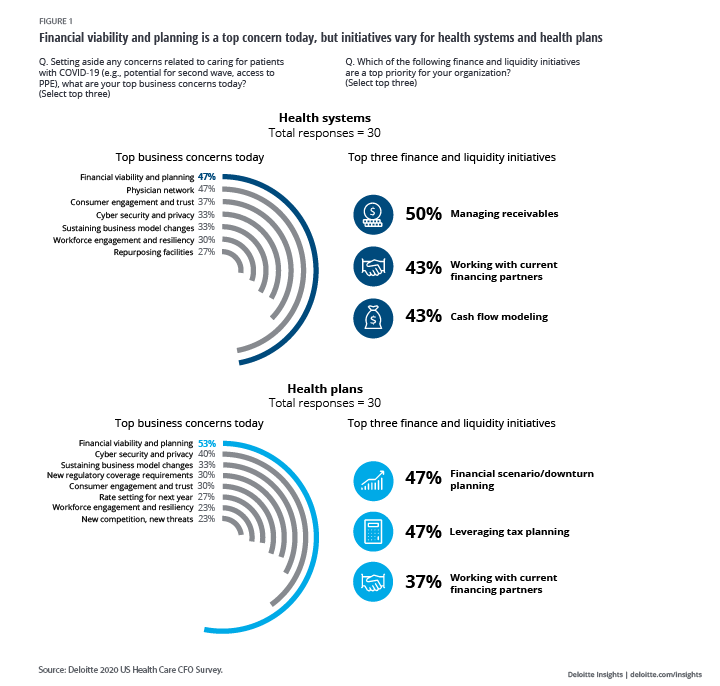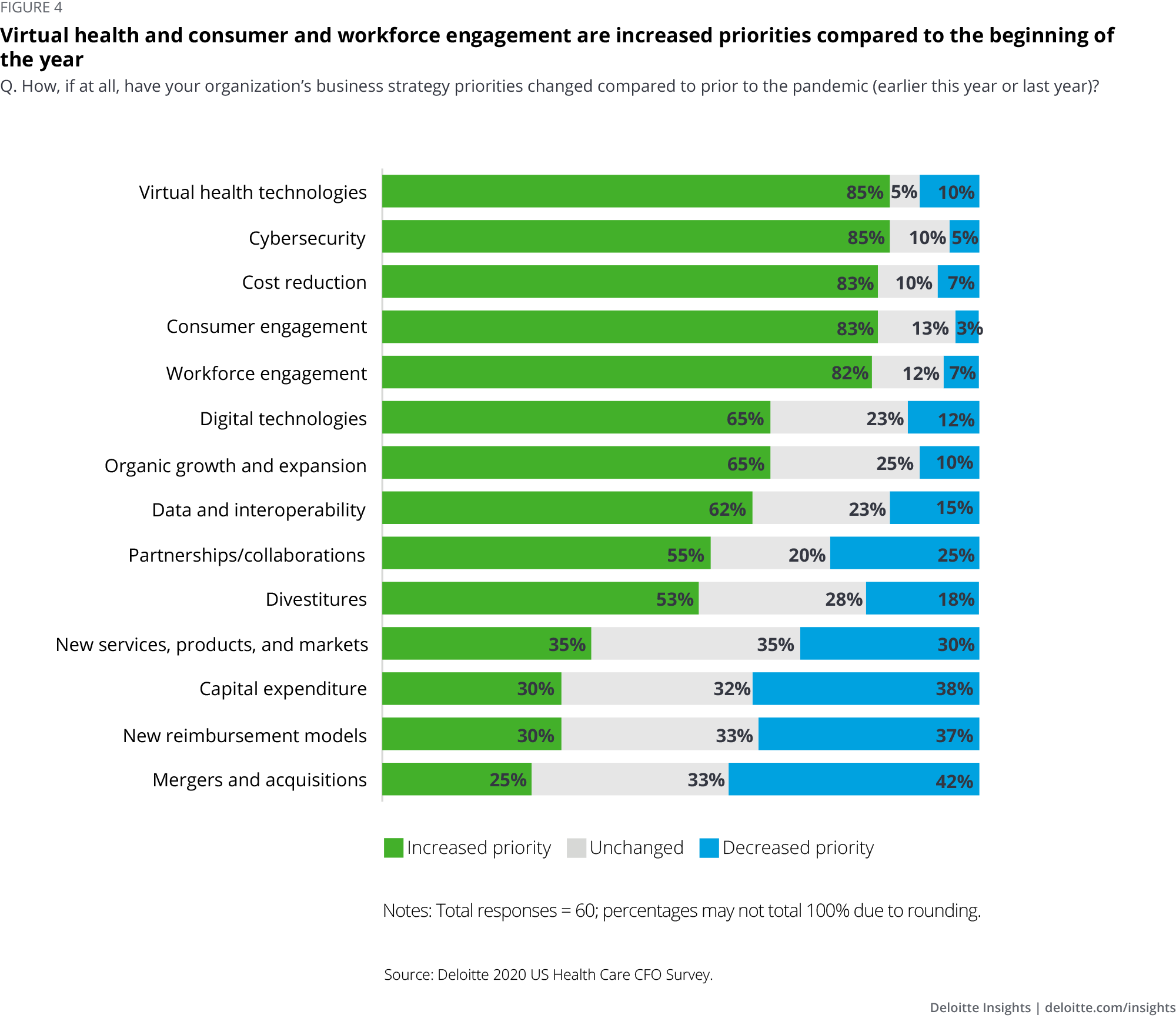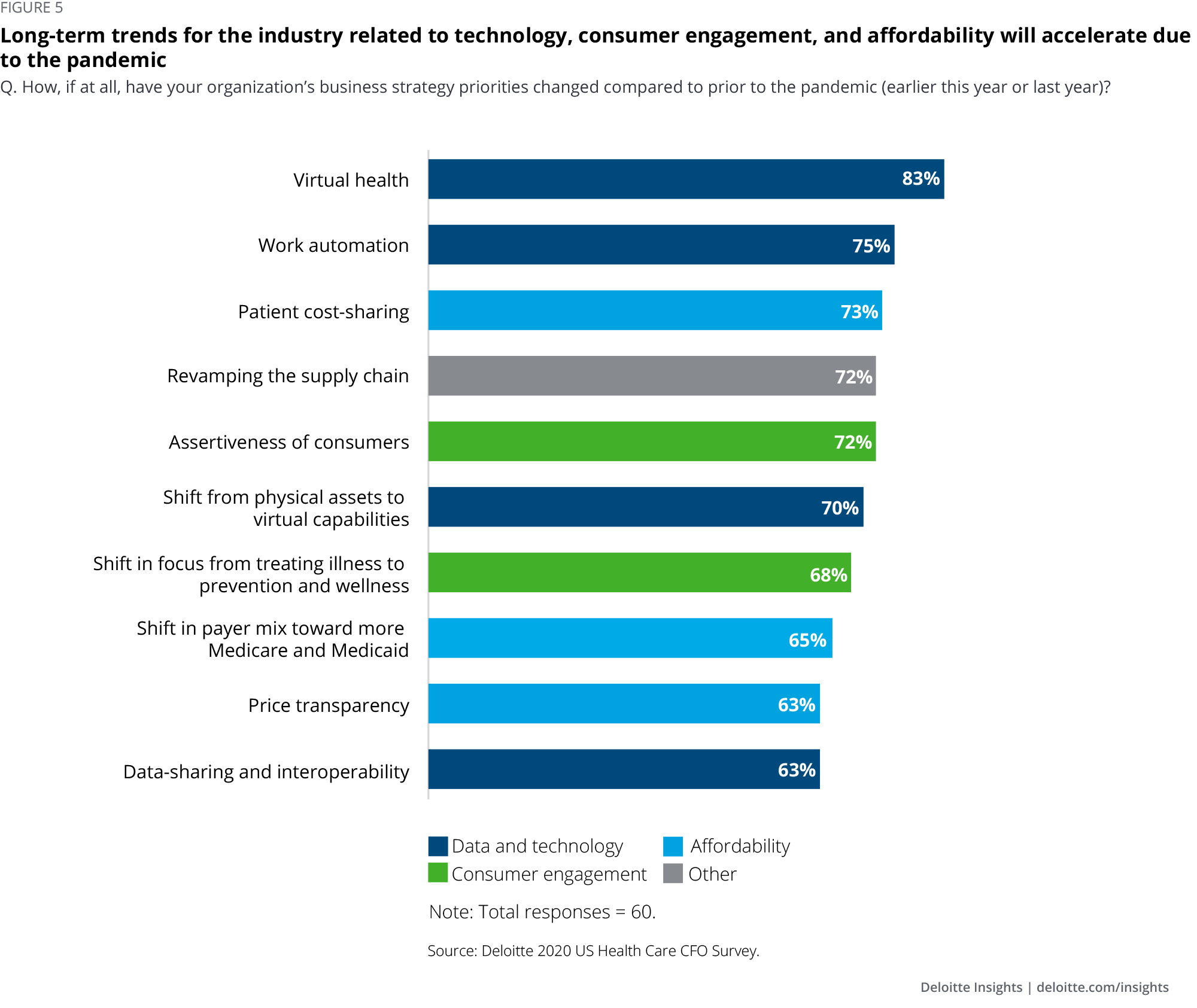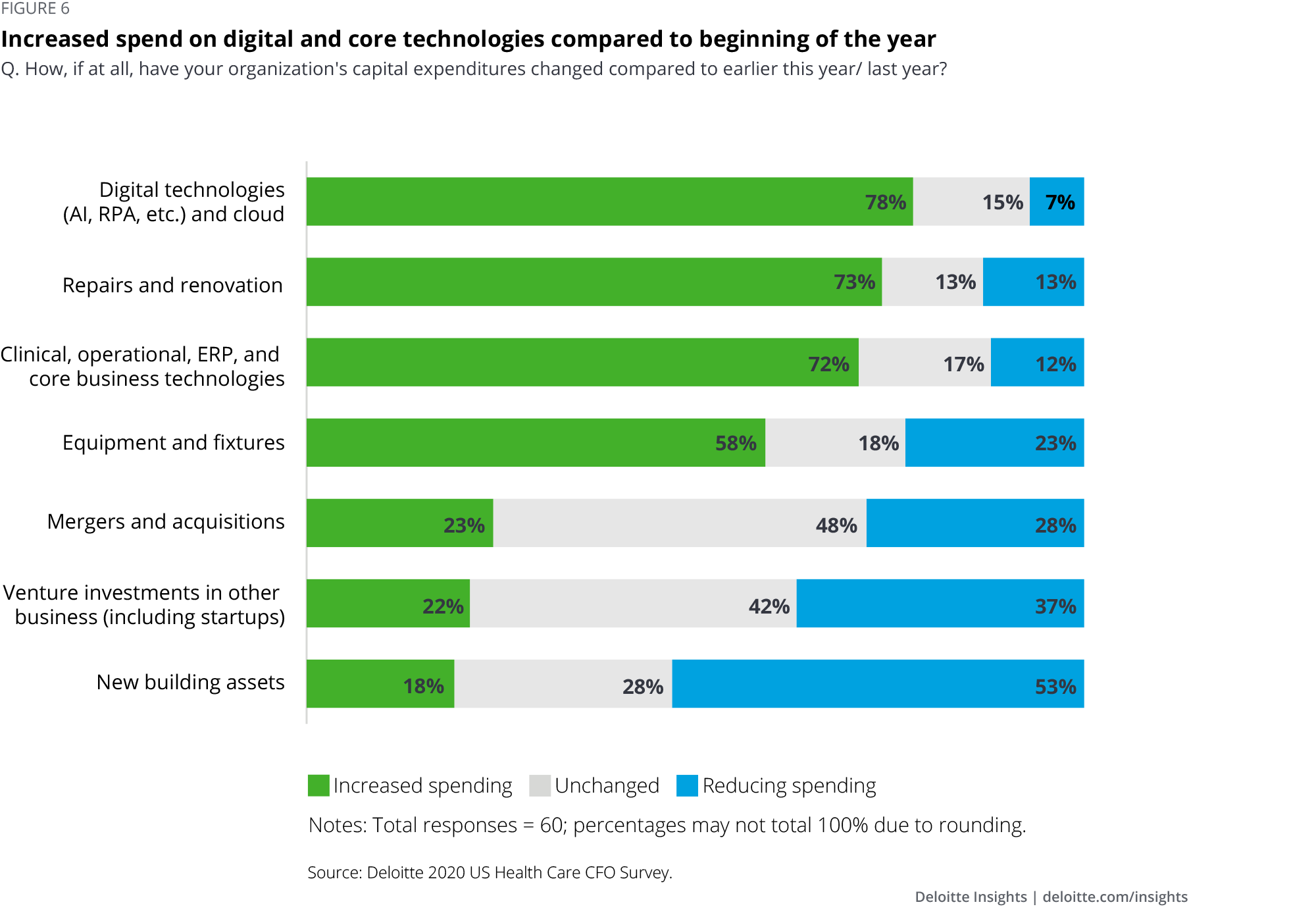
Building resilience during the COVID-19 pandemic and beyond How health care CFOs are navigating with an eye on the future
15 minute read
10 September 2020
From immediate financial impact and strategy shifts to a greater focus on consumers and virtual, explore how health care chief financial officers see ways to navigate the challenges of the pandemic while still driving their organizations’ long-term success.
Executive summary
Many stereotype the health care industry as slow to change and adapt compared to other industries.1 But the COVID-19 pandemic has created and is still creating an unprecedented crisis for the health care industry that has also triggered rapid and significant change. Investments and experience from today are likely to influence the industry for years to come. How are health care finance executives changing their strategies due to the pandemic? Which of these changes do they expect will endure from the pandemic?
Learn more
Explore the health care collection
Learn about Deloitte's services
Go straight to smart. Get the Deloitte Insights app
The Deloitte Center for Health Solutions surveyed 60 chief financial officers (CFOs) from health systems and health plans and interviewed another seven to learn how health care CFOs are navigating the challenges of the pandemic while trying to drive the long-term success of their organizations. They said that the pandemic resulted in:
Unprecedented long-lasting challenges: CFOs predict that the financial impact of the pandemic will be long and significant for the industry.
- The median expectation for hospitals to recover financially from the pandemic is 12 months, with a range of 3–24 months.
- Forty-seven percent of health system CFOs and 53% of health plan CFOs say that financial viability and planning are their biggest concerns (the top response).
Even greater focus on consumers and virtual health: CFOs are rethinking how they engage consumers, conduct work, and deliver care.
- Fifty-five percent say that consumer trust is the top driver of strategic changes in the short term (the top response).
- Eighty-three percent say that consumer engagement is an increased priority for their organization after the pandemic.
- Eighty-five percent say that virtual health technologies are an increased priority postpandemic.
Future-focused investments: Many have shifted capital spending toward supporting virtual capabilities versus brick-and-mortar buildings compared to last year.
- Seventy-eight percent expect to increase their capital spending on digital technologies.
- Fifty-three percent expect to reduce capital spending on new building assets.
Balancing an organization’s financial sustainability during a crisis and steering toward future success is no small task. CFOs must not lose sight of the future while responding and recovering from today’s challenges. Financial scenario planning, nimble decision-making, prioritizing investments in virtual and digital technologies, focusing on consumers, shifting to value-based care, and exploring collaboration and partnership opportunities should be a key part of every health care CFO’s playbook.
Introduction
The COVID-19 pandemic has created an unprecedented crisis for the health care industry. The country’s hospitals, health systems, and health plans have taken extraordinary steps to respond to the pandemic. Hospitals and health systems quickly added bed capacity, created modular ICU units, sourced personal protective equipment (PPE), devised safety protocols, and treated hundreds of thousands.2 Health plans waived out-of-pocket expenses, relaxed prior authorization requirements, expanded access to virtual health, and supported vulnerable communities with food and shelter.3
The crisis also created financial vulnerabilities for health care organizations. The American Hospital Association estimated the financial impact of COVID-19 on hospitals at US$202.6 billion between March and June 2020.4 This includes revenue loss due to canceled elective procedures and additional costs from COVID-19 hospitalizations, PPE, and workforce support programs.
Health plans have benefitted from the lower cost trend during this period. However, many expect some negative impacts from the medical loss ratios (MLR) requirements to pay rebates and the expected shift in enrollment from employer-sponsored coverage to Medicaid, individual insurance exchanges, and uninsured due to the recession.5 Health plans also face considerable uncertainty in setting premiums for 2021, not knowing how the pandemic will unfold.
As health care organizations respond to the crisis, their CFOs have one of the toughest challenges at hand—ensuring financial sustainability while planning for their organization’s future. To learn more, we surveyed 60 health care CFOs, and further interviewed seven health system CFOs (see sidebar, “Research methodology”).
Research methodology
The Deloitte Center for Health Solutions surveyed CFOs of 60 large health care organizations with a focus on understanding their strategic priorities, investments, and top challenges. The respondents included:
• 30 from health systems, all with revenue more than US$1 billion
• 30 health plans, 80% with enrollment more than US$1 million
We also interviewed CFOs of seven diverse, large health systems—integrated delivery networks, for-profit, nonprofit, and faith-based organizations.
Research findings
The financial impact of the pandemic has driven many health care organizations to quickly change their strategies.
Since the onset of the pandemic, the financial performance of two sectors—health systems and health plans—have been like mirror images; one part of the industry’s loss of revenue has been the other part’s loss of cost. While health systems struggled financially, fewer claims largely benefitted health plans’ margins. Despite these differences, the surveyed CFOs for both health systems and health plans were unanimous in naming financial viability and planning as their biggest concern today (figure 1).
"The biggest unknown—and I shared this concern with my peers—what will be the new normal. A lot of my time goes into scenario planning."—CFO, large integrated health system

The different finance and liquidity initiatives of health systems and health plans provide insights into their top concerns:
- For health system CFOs, managing receivables to maximize revenue and working with finance partners to leverage and access debt are the top financial initiatives. Many interviewed CFOs discussed how they immediately drew upon lines of credit to cushion against future financial challenges when accessing debt could be more difficult.
- For health plan CFOs, financial scenario planning is a top priority; for example, to understand different scenarios on MLR rebates and shifts in payer mix and line of business.
Two in three surveyed CFOs reported changing their organizational strategy due to the pandemic. While financial performance is a top-of-mind concern, when asked about the biggest drivers of change in organizational strategy, consumer trust and safety topped the list (figure 2). The CFOs we interviewed were working on best practices for reengaging consumers. In particular, several short-term changes in their strategy focused on measures to ensure their patients felt safe, such as frequent facility sanitization and app-based no-contact check-ins.

When will the hospital industry recover financially from the pandemic? It’s complicated, according to CFOs.
It was striking how wide the predictions were for financial recovery. When asked about the time it will take for the hospital industry to reach the financial levels of the previous year, responses from the CFOs of both health systems and health plans ranged from three months to two years. The median response was 12 months.

Factors influencing this prediction include:
- Volume. Several interviewed CFOs said volume may not return to pre-COVID-19 levels given consumers’ concerns and the safety protocols in place. The task at hand today is to estimate new-normal volume levels.
- Payer mix. While a majority of the health system CFOs haven’t yet witnessed a significant change in payer mix, they predict a shift toward more Medicare in the near future (due to the disproportionate impact of COVID-19 cases on seniors) and toward Medicaid and uninsured patients (due to unemployment levels).
- Case mix. Some CFOs reported a higher proportion of high-acuity patients (mainly driven by COVID-19 patients), which drove a higher case mix and thus higher payments for those patients.
Rethinking industry norms and shifting toward the future
As CFOs retool their strategies in response to the pandemic, their areas of focus and investment priorities look to shatter some long-standing assumptions about the health care business and position them toward the future of health.
Virtual care and virtual work are table stakes
The pandemic demonstrated the value of virtual care and virtual work much faster and in ways we could not have imagined had the industry waited for longer-term trends to play out. Before the pandemic, the discussion on virtual health or virtual work remained limited for health care organizations, showing great promise but with low adoption.
Of the surveyed CFOs, 85% said virtual health technologies are an increased priority for their organization today compared to the beginning of the year (figure 4). Many interviewed CFOs told us that both consumers and physicians were supportive of virtual visits due to ease of use, supportive access and payment regulations, and better outcomes. They expect the trend to continue and even become the default option for routine care and postoperative follow-up visits, consistent with our previous research on the future of virtual health.6
"The growth in (virtual health) volume is phenomenal, and we are already investing a lot. Our goal is never to go back. Both physicians and patients are loving it. Physicians found new productivity tools, and for the patients, it is a huge convenience factor."—CFO, large not-for-profit health system

Workforce engagement emerged as another area of increased priority (figure 4). This was a concern for both health systems—supporting staff during an unprecedented crisis—and health plans—engaging a newly remote workforce. To address workforce safety and burnout, several interviewed CFOs reported working on short- and long-term virtual work strategies and new financial programs to benefit frontline staff. Many CFOs said they hoped virtual work would endure for many functions, such as finance, information technology, and revenue cycle.
Consumer is front and center instead of an afterthought
For health care organizations, keeping consumers engaged is an even higher priority than it was at the beginning of the year (figure 4) because the nature of their relationship is changing. They no longer see many consumers in person due to the pandemic, and industry trends are shifting toward greater consumer involvement in decision-making. The interviewed CFOs pointed to consumer trust and safety concerns as a top priority and discussed how they needed new communication channels to teach consumers about their safety initiatives. Many interviewed CFOs also said that this is the best time to engage with consumers beyond their care and treatment needs. Some are using virtual visits to discuss well-being, access, and drivers of health, which they hope will make consumers value their relationship in the longer term and help build a more loyal consumer base. In fact, when asked about the long-term industry trends that will accelerate due to the pandemic, the surveyed CFOs pointed to cost-sharing, consumer assertiveness, and focus on well-being (figure 5). Each of these is likely to shift the industry toward even greater consumer influence on decisions.
"We have some ambulatory locations that are old and dingy. They won’t be acceptable to consumers anymore. People just didn’t notice earlier, but now they are hyper-sensitive. So, we need to make changes to workflows, which will be permanently different."—CFO, large regional health system

Proliferation of digital technologies
Nearly four in five CFOs reported increasing their capital spending on digital technologies, including artificial intelligence (AI), robotic process automation (RPA), and cloud (figure 6). With virtualization of care and processes and the proliferation of data, the CFOs said they are increasing their focus on intelligent use of this data, supported by interoperability, AI, and automation. The uses are manifold—they expect these technologies to enable care delivery, improve access, reduce costs by automating tasks, and more importantly, improve consumer experience through convenient, user-friendly tools such as those that enable online scheduling and communications.

Nimble decision-making
Survey responses of health care CFOs on which of the changes from the pandemic they hoped would endure pointed toward rapid decision-making at the organization, operations, and finance levels. Interviewed CFOs provided some context for this response. They acknowledged that historically, health care organizations have been slow to make decisions due to size, structure, and resources. However, as frontline organizations in responding to COVID-19, they could not delay decision-making. Several interviewed CFOs reported creating executive command centers, gaining consensus on ownership and governance structures, and quickly assigning decision-making powers. As a result, organizations were able to take quick actions on the organization’s finance, technology, operations, and human capital.
"We found we can move quickly as we did in this crisis to adjust. We created an incident command center. We were really able to standardize quicker and got buy-in rapidly. Those were good learnings as management team, and I hope these endure."—CFO, large, national faith-based health system
With these changes come new strategic decisions
Key decisions both the health system and health plan CFOs face include industry partnerships and value-based care and payment models. In addition, health system CFOs also weighed in investments in virtual vs. brick-and-mortar.
Virtual vs. buildings
Many interviewed CFOs discussed how they paused capital investments during the pandemic, particularly in buildings and bed towers. They saw the acceleration of virtual health and virtual work resulting in less demand for business and clinical space. Some hope that their virtual trends continue. Now, many face the decision of what to do with assets.
Fifty-three percent of surveyed CFOs said that they are reducing spending on new building assets compared to the beginning of the year (figure 4). Interviewed CFOs discussed pausing planned capital projects until they had reassessed demand and understood their longer-term financial position. Many said that they were rethinking hospital bed towers that were expansions vs. upgrades, with priority given to projects that would improve the consumer experience through integrated digital technologies in physical spaces and better ergonomics. Some recognized the possibility of needing fewer beds in the longer term.
Both health systems and health plans have office space that they may no longer need due to virtual work. Some interviewed CFOs said that they are rethinking their leased space. Reducing these leases could save money but most have long-term leases and landlords to contend with before they can act. Others said they are considering reconfiguring their clinics to include space for clinicians to conduct virtual visits.
"Given we are doing more video visits, does that mean we change our (real estate) strategy? The answer is yes. We will have a more conservative approach to the buildings. We are trying to build flexibility for the future."—CFO, large integrated health system
Partnerships and collaborations vs. mergers and acquisitions
CFOs discussed the growing desire for partnerships—both as opportunities for growth as well as to collaborate to improve care delivery, costs, and outcomes for their patients, members, and communities. Both health systems and health plans identified collaborations and partnerships among themselves and with each other as a preferred route for inorganic growth in the short term.
When asked about consolidation, interviewed CFOs agreed that the pandemic would likely accelerate M&A among hospitals and with physicians, but they think M&A may now be more complex and require more time as organizations gain a better understanding of the long-term financial impact of COVID-19. Compared to the beginning of the year, more than 60% of health systems reported increased priority for partnerships and collaborations compared to just 23% listing M&A as a priority. Similarly, when asked about initiatives in response to the pandemic, two of the top three initiatives included collaborations with other health plans (53%) and with health systems (43%), with M&A as the least important initiative (13%). However, M&A activity can be hard to plan for, and the current dynamic environment will create an increasing need for CFOs to react quickly to marketplace opportunities and threats.
Many interviewed CFOs said they had seen a great deal of collaboration with new organizations—other health systems, other health plans, employers, vendors, and community organizations. Many hope that these relationships will endure and improve the industry.
"Financial resilience has come to the fore. As a strategy, we are working on strong partnerships to depend on and grow as an organization. From an M&A perspective, it’s expensive to go through the process."—CFO, large for-profit health system
Value-based care vs. volume
As health system CFOs worried about the return of volume to pre-COVID-19 levels, they acknowledged that value-based and capitated contracts help insulate many from the financial challenges of those still heavily involved in fee-for-service. They agree that there will be more interest in these types of contracts to help mitigate future pandemic and volume worries. Besides, they expressed confidence that more health plans are on board with capitated and other forms of risk-based contracts, with a desire to move away from fee-for-service sooner.
In the short term, there were concerns for those participating in Medicare and commercially advanced payment models over skewed benchmarks for payment calculations as a result of the pandemic. However, health system CFOs noted that won't deter them from accelerating toward value-based care arrangements in the longer term.
"Pursuing value and taking on more risk—this is going to continue. [Health systems] will pursue it even more as there is more consolidation. As they get larger, it allows them to take on more risk."—CFO, large faith-based health system
Resilient finance leaders show the way
Amid widespread financial uncertainty and unprecedented challenges, the CFOs of some health care organizations are setting an example of resilient leadership. For instance, one of our CFO interviewees from a large health system located in a COVID-19 hotspot in the United States demonstrated the art of resilient leadership in three distinct ways.
- Respond decisively. Decisive action—with courage—is essential. At the onset of the pandemic, the health system quickly stopped discretionary spending, created dynamic financial scenario planning models, and planned for potential lines of credit, including debt.
- Recover and learn. After initial response planning, leaders quickly adopted a nimble review plan to assess all the finance and business continuity initiatives, identify pitfalls that can be avoided during a potential second wave, and share best practices to learn from competitors and other health systems.
- Thrive in the next normal. Even as they worked on their day-to-day strategies, the leaders charted their long-term plan, including reprioritizing their strategies based on new-normal financial planning scenarios. They prioritized their investments in digital and virtual technologies, initiated dynamic instead of static budgeting, and stress-tested current and potential future capital structures.
Conclusion
While the pandemic has created a significant crisis for the health care industry, many CFOs see positive changes. While they still face significant financial challenges today and in the coming months, many see the opportunity to use the momentum to position their organizations for future success.
As CFOs navigate the pandemic and steer their organizations toward the future, they should consider seven critical dimensions.
- Consumer: Consumer sentiment and trust will likely drive the speed at which demand for services and health care spending return. Health systems will need to reearn consumer trust through communication and demonstration of enhanced protocols, particularly for in-person visits. Health plans will need to develop and support consumer-friendly tools that support network decisions and improve understanding of out-of-pocket costs.
- Clinical: The prioritization of services will be critical and likely require a thoughtful balancing of urgency and health equity. As more research emerges about the long-term effects of COVID-19, health care organizations will need to ensure that their care models and services are agile to address patient and member needs in the context of potential additional waves of outbreaks.
- Financial: Health care organizations should continue challenging traditional financial decision-making to seek revenue recovery and growth opportunities. They should prepare for rapidly evolving reimbursement models as COVID-19 forces realignment of needs and value. Both health systems and health plans should continue to shift their organizations toward more cost- and risk-sharing to drive finances focused on value. In addition, the competitive landscape may evolve quickly, impacting capital planning and volume assumptions.
- Technology: The acceleration of virtual and digital adoption requires investment in technology to manage increased demand as well as defense against cyber risk. Health care organizations should strive for seamless synchronization between in-person and virtual services. They should consider leveraging cloud technologies and ensure appropriate security strategies and remote access controls to support virtual health innovations.
- Work: A healthy, dynamic, protected, and informed health care workforce (whether in front of a consumer or at a computer and desk) can help support a smoother transition when ramping up operations. Health care organizations will likely want to establish dynamic staffing models to account for variable demand to mitigate the effects of potential future waves and support workforce safety. For those functions where it makes sense, organizations should continue remote work. In addition, organizations should invest in providing emotional and well-being support to staff.
- Community: Health care organizations will need to responsibly engage their communities within parameters defined by local, state, and federal guidelines. Community collaboration around data and protocols will likely be critical not only to minimize the spread of infection, but for further research and innovation. When prioritizing services, organizations should maintain focus on their mission and how to bring value to their communities. Health systems and health plans should consider how they can continue to work together even more closely beyond payment mechanisms.
- Supply chain: To help mitigate the impact of potential future waves, health care organizations will want to balance resource availability with the need to design new processes to manage and deliver services. A revamp of infrastructure may be required to support a shift in service mix and delivery modalities. Establishing a dynamic and resilient supply chain will be critical for both PPE and other standard supplies.
More on health care
-
Are consumers already living the future of health? Article4 years ago
-
The role of health services innovators in the future of health Article4 years ago
-
How the virtual health landscape is shifting in a rapidly changing world Article4 years ago
-
Is the hospital of the future here today? Article4 years ago
-
Clinical leaders' top concerns about re-opening Article4 years ago










